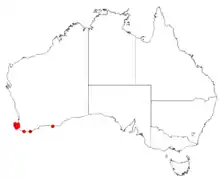Boronia anceps
Boronia anceps is a plant in the citrus family, Rutaceae and is endemic to a small area in the south-west of Western Australia. It is a perennial herb with small leaves and pink, four-petalled flowers.
| Boronia anceps | |
|---|---|
| Scientific classification | |
| Kingdom: | Plantae |
| Clade: | Tracheophytes |
| Clade: | Angiosperms |
| Clade: | Eudicots |
| Clade: | Rosids |
| Order: | Sapindales |
| Family: | Rutaceae |
| Genus: | Boronia |
| Species: | B. anceps |
| Binomial name | |
| Boronia anceps | |
 | |
| Occurrence data from Australasian Virtual Herbarium | |
Description
Boronia anceps is a perennial herb that grows to a height of 60 cm (20 in), has flattened stems and lacks a lignotuber. Its leaves are narrow egg-shaped to narrow oblong about 20 mm (0.8 in) long although those near the top are very reduced. The flowers are pink or pinkish purple and are borne in a cyme on the tip of the stems. The groups of flowers are on a thin peduncle up to 60 mm (2 in) long, each flower on a thin pedicel 5–10 mm (0.2–0.4 in) long. The four sepals are dark red, narrow triangular to broadly egg-shaped and 2–4 mm (0.08–0.2 in) long. The four petals are broadly egg-shaped and about 8 mm (0.3 in) long with their bases overlapping. The style and stigma are continuous. Flowering occurs from September to December or January.[2][3]
Taxonomy and naming
Boronia anceps was first formally described in 1998 by Paul G. Wilson and the description was published in Nuytsia from a specimen collected near a crossing on the Scott River near Augusta.[4][2] The specific epithet (anceps) is a Latin word meaning "two-sided",[5] referring to the shape of the stem.[2]
Distribution and habitat
This boronia grows in seasonally swampy heath and is only known from between the Scott River and Walpole.[2][3]
Conservation
Boronia anceps is classified as "Priority Two" by the Government of Western Australia Department of Parks and Wildlife[3] meaning that it is poorly known and known from only a few locations but is not under imminent threat.[6]
References
- "Boronia anceps". Australian Plant Census. Retrieved 14 March 2020.
- Wilson, Paul G. (1998). "New names and new taxa in the genus Boronia (Rutaceae) from Western Australia, with notes on seed characters". Nuytsia. 12 (1): 132–133. Retrieved 28 July 2019.
- "Boronia anceps". FloraBase. Western Australian Government Department of Parks and Wildlife.
- "Boronia anceps". APNI. Retrieved 20 February 2019.
- Brown, Roland Wilbur (1956). The Composition of Scientific Words. Washington, D.C.: Smithsonian Institution Press. p. 87.
- "Conservation codes for Western Australian Flora and Fauna" (PDF). Government of Western Australia Department of Parks and Wildlife. Retrieved 22 February 2019.
